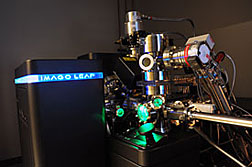- Number 366 |
- July 2, 2012
Understanding of radiation damage LEAPs forward

The Localized Electron Atom Probe (LEAP)
at INL.
A faint nightclub beat greets visitors to a small room at DOE's Idaho National Laboratory housing the Localized Electron Atom Probe (LEAP). But that’s no stereo cranking out house music; it’s a rhythmic pump cooling a tiny sample to more than 220 °C below zero (that’s -425 °F). Deep within, the device is taking apart, atom by atom, a bit of ceramic smaller than the tip of a pin.
The work can help researchers understand factors that may cause weaknesses in materials exposed to prolonged radiation inside a nuclear reactor. INL is leading efforts to adapt advanced techniques such as LEAP for use on irradiated materials. In fact, this LEAP has generated some of the clearest results ever obtained for samples that mimic irradiated fuel.
A new research paper co-authored by INL scientist Melissa Teague describes that work. Such research efforts can provide a more fundamental understanding of how radiation damages materials inside nuclear reactors.
An up-close look at radiation damage
Nuclear energy has safely provided the largest portion of carbon-free electricity in the U.S. for more than half a century. Yet nuclear engineers work to understand how radiation affects materials so they can develop ways to make the energy source ever safer and more efficient.
Studying weaknesses in irradiated materials on a microscopic level can provide molecular insight into what makes them prone to cracking. Such work enables advances to make materials more radiation-resistant.
But irradiated materials can be brittle and highly radioactive. The special challenges associated with handling them make it difficult for researchers to utilize advanced examination tools that have become routine for other scientists. INL has been pioneering methods to put such techniques within reach for irradiated materials research.
The INL research collaboration analyzed irradiated fuel-like samples using an advanced LEAP instrument and submitted the findings for publication in the Journal of the American Ceramic Society.
Hallmarks of stability in nuclear fuel
New types of nuclear fuel could boost efficiency by wringing more energy from each fuel rod. For example, mixed oxide (MOX) fuel containing both uranium and plutonium has been used in fast breeder reactors, but the long-term performance of MOX fuels is not yet well understood.
To determine how irradiation may weaken nuclear fuel elements, researchers need to understand molecular-level changes caused by the fission process. Specifically, when an ejected neutron bombards an atom and splits it in two, the team wants to know if the fission products congregate together or stay put.
"Do they segregate or are they more stable and immobile?" Teague and her collaborators at the Colorado School of Mines want to know. "If they're mobile, that can compromise stability or damage the protective fuel cladding."
Such information is hard to come by, but Teague and her colleagues have demonstrated how to get it. The team irradiated cerium-oxide — a close relative that can serve as a surrogate for MOX fuel — and analyzed it using the LEAP.
After the probe disassembles the material, a computer collects data about each atom, which researchers feed into software that helps reconstruct the sample. The information can reveal, in minute detail, how the material responds to irradiation.
The future of nuclear materials research
Such understanding drives development of new materials with significantly improved performance, a core aspect of INL's nuclear research mission.
Oak Ridge National Laboratory and the University of California, Santa Barbara (UCSB) — both INL collaborators — pioneered LEAP analysis of irradiated materials. The LEAP extends these capabilities for irradiated fuels and is accessible to outside collaborators through the Center for Advanced Energy Studies and DOE's Advanced Test Reactor National Scientific User Facility, both based at INL.
Meanwhile, Teague's work continues to bring the LEAP online for irradiated fuels testing. Teague and her team have now prepared unirradiated samples of genuine MOX fuel for testing. They expect to be examining irradiated MOX fuel samples with the LEAP this summer.Submitted by DOE’s Idaho National Laboratory
